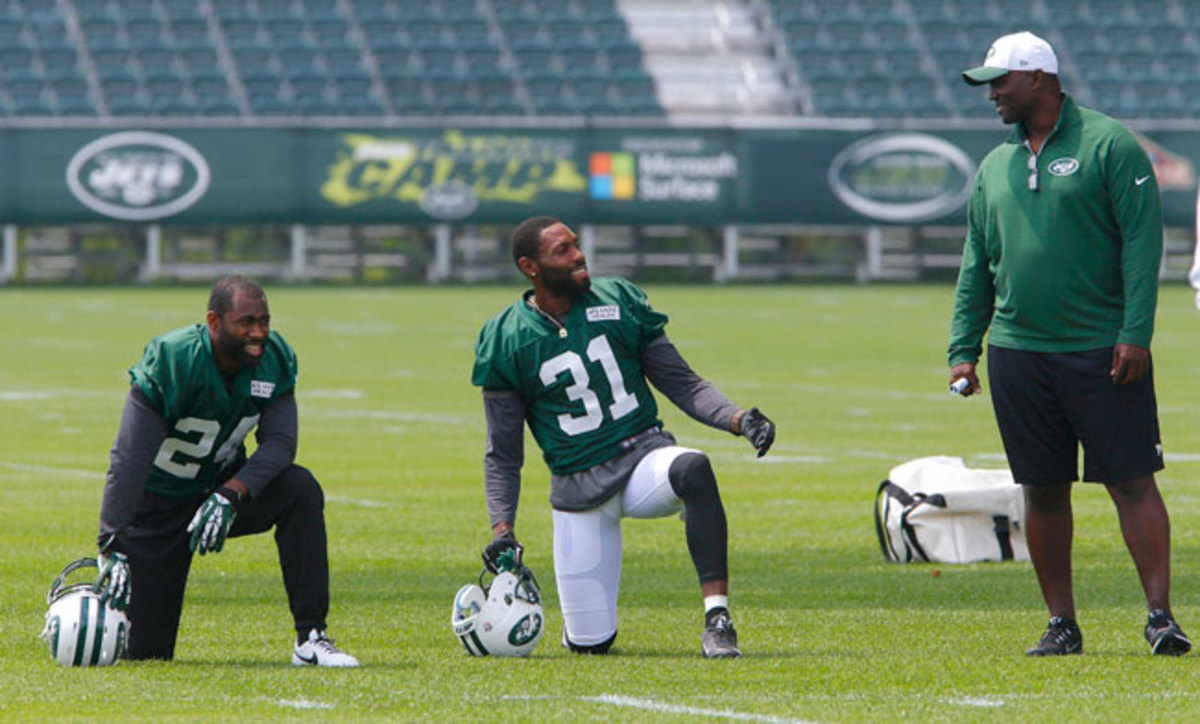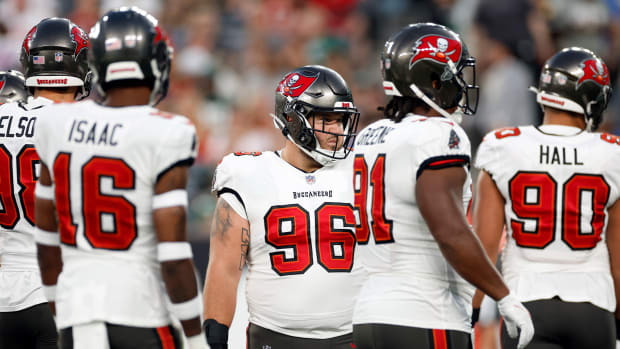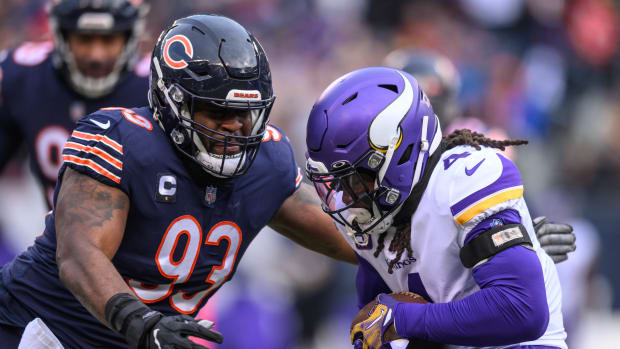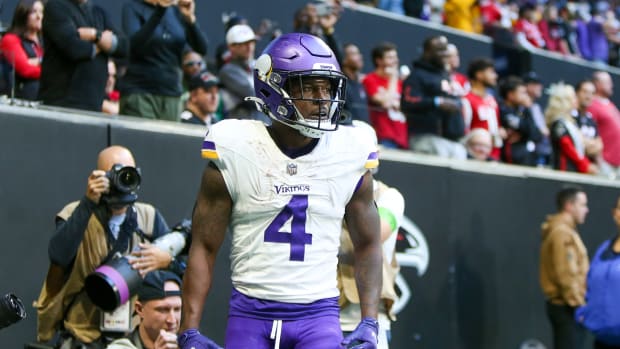
Todd Bowles Has No Limits
The most envied scheme in professional football belongs to Todd Bowles, because the Jets coach has figured out how to dictate the action without having dominant edge rushers. Labeling Bowles’s scheme, which he sharpened as the Cardinals’ defensive coordinator over the past two seasons, is an inexact science; most would describe it as a 3-4, but there are several times when he’ll employ a four-man front. The labeling is mostly academic anyway. Structure doesn’t define Bowles’s system. Concepts do, especially nickel and dime sub-package concepts.
The main concept: controlling the terms of engagement by sending—or threatening to send—aggressive pressure. The only other coach in recent years who has consistently thrived with this approach is the man Bowles has replaced. Rex Ryan never had quality edge rushers with the Jets, but he made offenses uncomfortable by rushing extra bodies or showing a blitz but rotating out of it after the offense had adjusted.
Bowles is just like Ryan, except that he follows through on his blitz threats more often. He’s one of those just-crazy-enough-to-do-it guys. That’s what makes his scheme go. A defensive coordinator typically limits his pressure calls to certain scenarios and areas of the field. Bowles has no limits. Even the most daring coordinators tend to only bring Cover-0 blitzes inside the 20-yard-lines, but Bowles will bring them at midfield. And he’ll bring them in two-minute situations, confusing offenses that are accustomed to seeing safe seven- or eight-man zone coverages against their hurry-up. The more critical the situation, the more aggressive Bowles is likely to be.
A lot of what Bowles does involves putting two extra defenders in the A gaps, which commands one-on-one matchups across a pass rush and stresses a quarterback up the middle. A lot of defenses give this look, only to drop the A-gap blitzers into coverage after the snap. Bowles will drop his linebackers plenty, but he’s also just as likely to rush both and bring a third man in behind them. Or rush both and also blitz a corner off the edge.
Given the dregs the Jets had a year ago, their upgrades at cornerback are breathtaking. Or infuriating, if you’re Rex Ryan.
Bowles played a three-safety, three-corner dime package about 60 percent of the time in Arizona last season. This had a lot to do with the Cardinals’ lack of depth at inside linebacker; the Jets have two quality inside backers (Demario Davis and David Harris) and will probably play more nickel under Bowles. But they also have a talented—though, at this point, underachieving—second-year safety in Calvin Pryor, who struggled when asked to play in space under Ryan. While he might not be a box safety like the bigger Deone Bucannon was in Arizona, Bowles will make him more of an attacker.
There are other options at safety. The best is Marcus Gilchrist, a smart, multidimensional defensive back who wore a lot of hats in San Diego’s 3-4 scheme. Gilchrist might be little known to some fans, but he’s a favorite of many coaches around the league. There’s also Antonio Allen, who can build on the coverage experience he picked up while moonlighting at corner last season.
Technically, Bowles calls a lot of Cover 3 zone concepts, particularly on base downs. But with so many highly specific matchup principles in his Cover 3, plus all the aggressive blitzing, the Jets for all intents and purposes will be a man-to-man defense. Hence the $39 million guaranteed shelled out for Darrelle Revis, the best cover corner since Deion Sanders. And the $32 million over four years (though none guaranteed after ’15) to Antonio Cromartie, who prospered in an outside No. 2 role last season under Bowles. And, just to ensure no leaks, the Jets also paid $13 million in guarantees to ex-Brown Buster Skrine. The 26-year-old ran hot and cold in Cleveland but showed increasingly stronger command on his considerable athleticism last season.
Given the dregs the Jets had a year ago, their upgrades at cornerback are breathtaking. (Or infuriating, if you’re Rex Ryan.) Credit first-year GM Mike Maccagnan. By acquiring tremendous man-to-man corners across the board, his rookie head coach can continue to dictate games through designer pressure concepts.
Of course, those concepts are dependent upon opponents first being put into obvious passing situations. To help this, the Jets refortified their stingy defensive front of Muhammad Wilkerson, Sheldon Richardson (suspended the first four games, perhaps more following his July 14 arrest) and Damon Harrison by selecting USC’s Leonard Williams with the sixth overall pick. Perhaps Williams will ultimately replace Wilkerson, who is in a contract year. But it’d be foolish to not re-sign the 315-pound monster. The best-case scenario with Williams: he becomes a force equal to what the long-armed Wilkerson already is.
However and with whomever they line up, the Jets will have a dominant defensive front. No question, Maccagnan had an incredible offseason for a first-year general manager. But the most important move he made was helping owner Woody Johnson acquire the league’s hottest head-coaching candidate.
Jets Nickel Package
1. While Maccagnan buttressed New York’s defense, his most immediately beneficial might prove to be correcting the offense’s glaring weakness at wide receiver. He used a second-round pick on Ohio State’s Devin Smith, who could eventually be an upgrade over the mediocre Eric Decker. He also got Brandon Marshall for a fifth-round pick. At 31, Marshall hasn’t yet lost a single step. And it will be a while before he does; his game is predicated on hauling in contested balls, not getting open via speed and quickness. Having a receiver who wins even when covered is critical given Geno Smith’s apparent eagerness to throw to covered receivers.
2. This negative on Smith—throwing into coverage—is correctable. Experience and more QB-friendly play-calling might be all he needs to move in a positive direction. Even though he runs well, Smith isn’t overly reliant on his legs. He’s willing to play in the pocket. That leaves hope; there’s something to build on. New offensive coordinator Chan Gailey needs to spread out and create more defined reads for Smith. The longer Smith holds the ball, the worse his decision-making becomes. As the Bills head coach in 2010-12, Gailey did a commendable job hiding Ryan Fitzpatrick’s limitations by calling spread concepts that often defined the quarterback’s reads and forced him to throw early in the down.
3. It might be tempting to make the ground game the offense’s foundation, but that’s tough given this O-line’s perplexing inconsistency in run-blocking last year. The only change to that line is at guard, where ex-Seahawk James Carpenter now starts opposite Willie Colon. Carpenter is undoubtedly an upgrade over third-year pros Brian Winters and Oday Aboushi (who isn’t impressive but some think may push Colon), but he struggles too much with balance to be anything close to a cornerstone player.
4. Some still might think that Quinton Coples can be an edge-rushing presence. No. Coples, in fact, came off the field in some passing situations last season. (He was often replaced by declining veteran Jason Babin, who remains on the depth chart behind Calvin Pace.) Just because a guy went to North Carolina and kind of resembled Julius Peppers doesn’t mean he’s Julius Peppers. Coples is too methodical to be a dynamic sub-package player.
5. It will be interesting to see what the Jets have in running back Stevan Ridley. Remember, the former Patriot rushed for 1,263 yards in 2012. Ridley has deceptive quickness and wiggle through the hole. Coming off an ACL injury, he will share carries with Chris Ivory, a nasty runner who is most effective in a committee role.
• Questions or comments? Email us at talkback@themmqb.com.




































